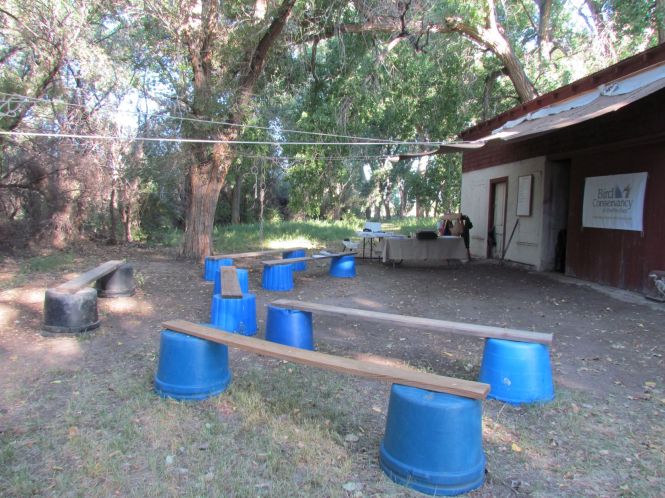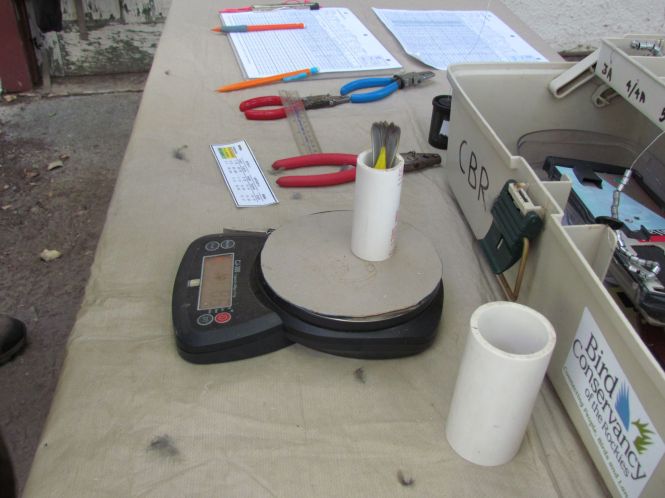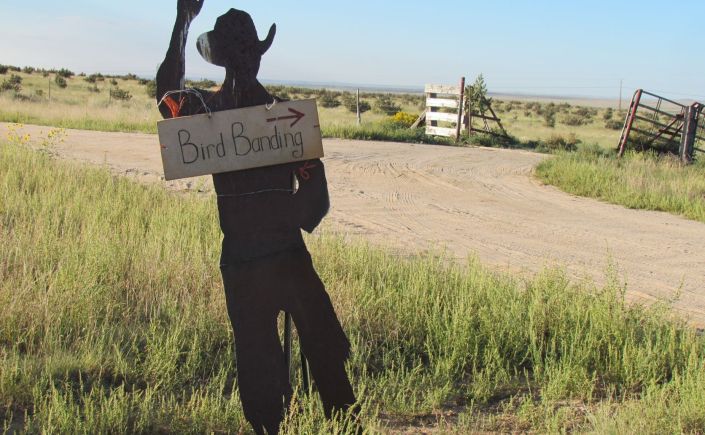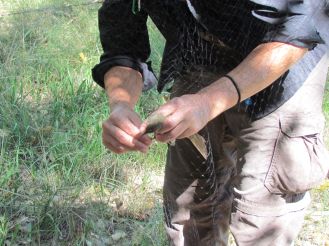Observing birds in their natural setting is one of my favorite pastimes. Because most will not tolerate being approached, binoculars are generally indispensable. Seeing wild birds from up close is a rare privilege, and banding stations (or ringing stations, for British English speakers) offer such views. One I am familiar with and have visited repeatedly is located not too far from Colorado Springs at Chico Basin Ranch, in the eastern reaches of El Paso County.
In addition to being an environmentally-conscious, conservation-oriented, active cattle ranch, Chico Basin is the number one birding hotspot in El Paso County (and number two in neighboring Pueblo County to the south, as it straddles the county line). Its terrain lies along an area where two migratory routes in North America—the Central and Pacific Flyways—overlap. The presence of water and trees in the middle of the plains is an invitation for birds to take a rest, which makes it an ideal site for a banding station.
Each spring and fall, the Bird Conservancy of the Rockies, under the auspices of the US Department of the Interior, organizes a month-long banding period staffed by master banders. So-called mist nets are erected in densely vegetated areas with high avian activity. Birds don’t see the nets and are caught in their fine mesh, from which they are carefully extracted. To keep them calm and protected until their evaluation, each individual is enclosed in a hand-sewn, seamless cotton bag corresponding to its size, and hung on a rack.

Benches for visitors, including school classes
To enlarge a photo, click on it. To read its caption, hover your cursor over it.
When it’s a particular bird’s turn, it is pored over painstakingly. Its species is identified, fat stores assessed, wingspan and tail length measured. Age is determined with the help of additional parameters, such as state of plumage, stage of molt, and degree of skull ossification; gender (in the absence of sexual dimorphism) by evaluating the sexual organs, which swell during the breeding season. When a captive’s identity is still uncertain, more arcane measurements are in order.
Banding stations are repositories of the tools of the trade, and of relevant ornithological literature. A copy of the “Bible” of banders, Peter Pyle’s Identification Guide to North American Birds is mandatory. Its two volumes illustrate and enumerate pertinent details that help banders determine what species they are holding. Nobody knows everything, but every bander knows where to look up information. And fast, to limit the amount of time a bird is handled, and the attendant stress.
A light, numbered aluminum band that does not interfere with the bird’s activities is selected and fastened to one leg, based on that extremity’s thickness. Experienced banders know which diameter to choose for each bird, but a nifty gauge can assist in the selection. In case a bird is recaptured (which happens infrequently), the band’s unique serial number allows tracking that individual’s movements as well as longevity and might offer intriguing information. In 2017, the Cornell Lab of Ornithology published an online article about a Yellow Warbler being banded in northern Colombia before it was re-captured in New York State 2 months later and 2,300 miles away—a small sensation.
The final step consists of establishing the bird’s weight by placing it head first in a tube wide enough to encircle it, but narrow enough to limit movement in order to prevent injuries. When it is finally released, it typically takes off from the bander’s flattened hand. Some do so immediately, others need a moment to get reoriented to their surroundings.

The Yellow-breasted Chat from the photo above is being weighed

While all this measuring is going on, the information needs to be recorded as well
The birds’ differing reactions to their capture are equally as fascinating as the itinerary they follow during their twice-annual migration. Some individuals seem silent and subdued, others anxious and agitated. A few appear utterly indignant at their confinement and loudly express their displeasure at being handled. And yet others look to be completely unfazed by the goings-on and get to pose for a moment for the admiring observers before returning to their pre-capture pursuits.

White-eyed Vireo, a rare visitor in El Paso County

Spotted Towhees are very common

Blue Jays are among the most vocal captives…

…as are Brown Thrashers…

Raptors, like this Cooper’s Hawk, are feisty and fierce (and seldom founds in the nets)
Banders in action remind me of dancers in an artfully choreographed performance. Birds, the beguiling ballerinas, are gently but assuredly lifted, repeatedly rotated, and finally released. As I watch these winged wonders vanish into the foliage of nearby trees after their brief ordeal, I wish them smooth sailing. May they gain enough weight during their layover to carry them securely to their breeding or wintering grounds and bless us with their presence again come next spring or autumn.
Click here for the German version/klicken Sie bitte hier für die deutsche Version:












Wonderful post. Learning about birds and teaching about them to the next generation is the only way to ensure their survival!
LikeLiked by 2 people
Thank you, Cathy. I agree with all my heart.
LikeLiked by 1 person
Amazing post.
What a great opportunity for both education and seeing these birds up close.
LikeLiked by 1 person
It is, Vicki. Thank you for stopping by and for commenting, despite your thumb. I hope it’s healing well!
Best,
Tanja
LikeLiked by 1 person
Thanks for asking, Tanja. I’m using the thumb as normal, but some days it’s very sore indeed and I have to stop typing or using it with some tasks. Since I have Fibromyalgia (allover body pain and a heightened sense of pain when hurt), I suspect this will become a new pain ‘site’ for a long time. Worried about the revelation of ossification right where I hold my camera (which could explain a lot of discomfort or soreness over the last couple of years).
LikeLiked by 1 person
I hope the pain won’t become chronic for you!
LikeLiked by 1 person
I loved this. I have long been familiar with banding and have seen banded birds but this is the first time I have read about the process.
LikeLiked by 1 person
Thank you for stopping by and for commenting. It is an amazing process to watch, and banding stations exist all across the country. Maybe you could find one close to your home and observe. It is so much fun.
LikeLike
This is very insightful. And you have handled a hawk too! I’m envious. 😀
LikeLiked by 1 person
Thank you, Nirmala. But I did not get to handle the hawk, nor most of the other birds. The handlers usually release them as fast as possible, to limit stress, and only allow photography when the birds are not too agitated.
LikeLiked by 1 person
Yeah, that makes sense.
LikeLiked by 1 person
The birds seem to be all different in personalities , just like us!
LikeLiked by 1 person
How true. It is really noticeable when one takes some time watching them.
LikeLiked by 1 person
Such a delicate event and so much is learned! Thank you for your informative post, Tanja. I’ve never attended a ‘bird banding’ but would love to one day.
LikeLiked by 1 person
I hope you will have the opportunity to witness this remarkable process, Donna, it is entirely captivating.
LikeLiked by 1 person
Thank you Tanja for such an amazing documentary – I knew almost nothing of bird banding before, so thanks again for examining this vital conservation task.
LikeLiked by 1 person
Thank you, Nigel, for stopping by and for commenting.
This is an amazing process, and I wish everybody could watch it at least once. I think it would change our attitude toward birds, nature, and conservation.
Best,
Tanja
LikeLike
[…] a post about bird banding a few weeks back, I mentioned Chico Basin Ranch, an active, environmentally-friendly cattle […]
LikeLike
[…] Not surprisingly, all this water and attendant life act as magnets for migratory birds as they travel along the edge of either the Pacific or Central Flyway which overlap in this part of the country. This special setting has made Chico Basin Ranch birding hotspot #1 in El Paso County, with 311 observed species, and #2 in Pueblo County, with 320 species, a high only exceeded by Pueblo Reservoir with 340 reported species. It is also the reason why one of Colorado’s three banding stations is operated on the El Paso County side of the ranch twice yearly during migration. If you would like to read about this fascinating experience in more detail, please take the time to visit this previous post. […]
LikeLike